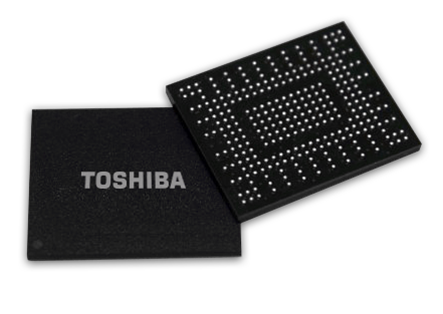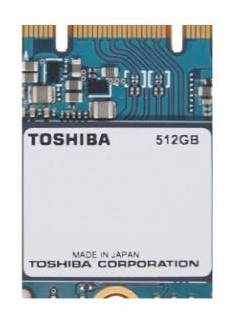Toshiba Announces New BGA SSDs Using 3D TLC NAND
by Billy Tallis on August 3, 2016 9:00 PM EST
Toshiba has announced a new generation of BG series single-chip SSDs, with a newer controller and expanded capacity options thanks to the adoption of 3D NAND. The BG series is Toshiba's SSD solution for tablets and ultrabooks that need a smaller form factor than a M.2 2280 module but higher performance and capacity than eMMC solutions.
Toshiba's BG1 series was first previewed at CES 2015. That first generation uses a PCIe 2 x2 link and implements the NVMe 1.1a protocol. The BG1 is available in capacities of 128GB and 256GB either as a 16mm by 20mm BGA package integrating both the SSD controller and NAND flash, or as M.2 2230 removable modules.
The new BG series switches from planar MLC NAND to Toshiba's BiCS 3D TLC NAND. The higher per-die capacity allows for the addition of a 512GB model and makes the package slightly thinner. The new SSD controller has been upgraded to operate at PCIe 3 speeds though still with only two lanes. It also now supports NVMe 1.2 including the optional Host Memory Buffer (HMB) feature. We've previously seen HMB implemented by a Marvell controller that also targets low-end NVMe applications.
Toshiba has shared some details about how they plan to make use of HMB and what its impact on performance will be. The BG series uses a DRAM-less SSD controller architecture, but HMB allows the controller to make use of some of the host system's DRAM. The BG series will use host memory to implement a read cache of the drive's NAND mapping tables. This is expected to primarily benefit random access speeds, where a DRAM-less controller would otherwise have to constantly fetch data from flash in order to determine where to direct pending read and write operations. Looking up some of the NAND mapping information from the buffer in the host's DRAM—even with the added latency of fetching it over PCIe—is quicker than performing an extra read from the flash.
Toshiba hasn't provided full performance specs for the new BG series SSDs, but they did supply some benchmark data illustrating the benefit of using HMB. Using only 37MB of host DRAM and testing access speed to a 16GB portion of the SSD, Toshiba measured improvement ranging from 30% for QD1 random reads up to 115% improvement for QD32 random writes.
| Performance improvement from enabling HMB | ||
| QD1 | QD32 | |
| Random Read | 30% | 65% |
| Random Write | 70% | 115% |
While it looks like HMB can do a lot to alleviate the worst performance problems of DRAM-less SSD controllers, the caveat is that it requires support from the operating system's NVMe driver. HMB is still an obscure optional feature of NVMe and is not yet supported out of the box by any major operating system, and Toshiba isn't currently planning to provide their own NVMe drivers for OEMs to bundle with systems using BG series SSDs. Thus, it is likely that the first generation of systems that adopt the new BG series SSDs will not be able to take full advantage of their capabilities.
Carried over from the previous BG1 series are support for TCG Pyrite and the option of full TCG Opal encryption support. The 16mm by 20mm BGA package is still only 1 gram for the highest capacity, and the maximum thickness is reduced from 1.65mm to 1.60mm. Power consumption may have increased slightly, with the new BG series SSDs drawing up to 2.8W when active compared to a specification of 2.2W typical for the BG1.
The new BG series SSDs are currently sampling to select OEMs, and will be in full mass production by the end of the year.
Source: Toshiba











14 Comments
View All Comments
DanNeely - Wednesday, August 3, 2016 - link
Unless Toshiba knows MS will be adding the feature to its generic NVME driver in the near future, not providing a driver of their own is an insane footgun.ddriver - Thursday, August 4, 2016 - link
I bet they will only offer drivers for that adware/spyware w10...asdacap - Wednesday, August 3, 2016 - link
One issue that I see with the HMD is that, what if the machine loses power? The HMD won't be able to flush data to the SSD.On the other hand, I could see that the HMD could be quite large compared to other SSD's on board DRAM. But then again it would take space that could be used as the OS's disk cache...
Billy Tallis - Wednesday, August 3, 2016 - link
The power loss concerns are probably why Toshiba is using the HMB only as a read cache. And they're not using much DRAM since they're not storing user data in the DRAM and are just caching a subset of the NAND mapping tables.DanNeely - Wednesday, August 3, 2016 - link
Normal consumer SSDs of any type don't have the capacitors needed to flush their caches in the event of power loss; so these aren't any more vulnerable than the rest of the non-enterprise drives on the market.ddriver - Thursday, August 4, 2016 - link
Capacitors on the SSD will do you NO good when your cache is not on the SSD but in system ram.DanNeely - Thursday, August 4, 2016 - link
True and irrelevant to what I said. Unless you're paying extra for an enterprise class drive, most SSDs don't have capacitors for their onboard ram either. Using system ram is no worse than the status quo on consumer SSDs with onboard ram. In both cases unexpected power loss will cost whatever is in the write cache.mapesdhs - Saturday, August 6, 2016 - link
Some consumer drives do have it, eg. Crucial M550.Always surprised me that Samsung's Pro series never had it though.
BrokenCrayons - Thursday, August 4, 2016 - link
BGA SSDs are probably intended for use in mobile devices that contain internal batteries and are largely protected from power losses under normal operation. Besides that, like Billy said, HMB isn't caching data that needs to be written to flash.Morawka - Wednesday, August 3, 2016 - link
this product looks at least 3 years behind what samsung offers. last month they announced a 512GB BGA NVME SSD with the controller, Nand and DRAM all in a smaller package than this.